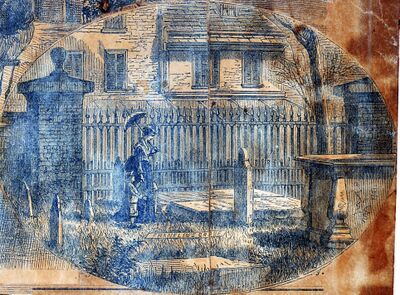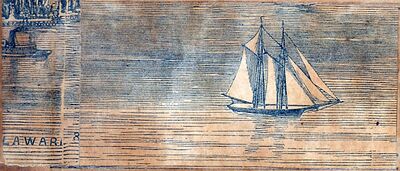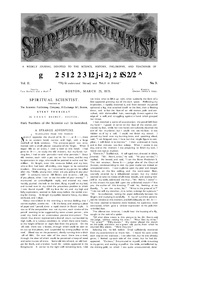
“Hope Evermore! Love Evermore! They Sing”


A Strange Adventure
Nearly opposite the church of St. N——, at B——, there is an ancient hotel, narrow and high, with a large roof full of little windows. The entrance-porch was ornamented with a small plaster statuette of the Virgin. When I began life as an artist, I took a room at this hotel. I had gone to B——, to study the old masters, but my funds running low, I had to take portraits—and what portraits! Stout old women, each with a pet cat on her knees, and fat rosy burgomasters in wigs, who would be painted in ochre and Vermillion. At length, even this resource failed, and my host, who at first had been all civility, now began to be somewhat insolent. One evening, as I mounted to my garret, he called after me, “Hollo, young man, when are you going to pay your bill? It amounts now to 160 florins and 10 cents; tell me, if you please, when I am to see the color of your money.” I murmured an unintelligible reply, and entered my room hastily, pushed the bolt in the door, flung myself on my bed, and turned over in my mind the precarious position in which I now found myself. All my love for art, and my high and lofty aspirations, seemed to fade away before the sordid craving for money. At length my eyelids became heavy, my ideas confused, and I slept.
About two o’clock in the morning, a nervous feeling, that I cannot explain, awoke me. I lit the lamp, and seizing a piece of paper and a pencil, drew a rapid sketch in Dutch style. It was as if the composition was not my own, each stroke of the pencil seeming to be suggested by some unseen person, who used my hand as an unconscious passive instrument The sketch thus drawn represented a dismal court, surrounded by high walls, in a ruinous condition, in which there were hooks, at the height of Seven or eight feet from the ground. On the eft side there was s lattice, through which could be seen an ox cut up into pieces, and suspended by strong pulleys to the roof. Blood was on the pavement, slowly running into a ditch ull of filth. On one side of the court there was a shed, through the door of which could be perceived a heap of wood and some trusses of straw. Some old bits of cord, an old hamper for fowls, and a broken hutch for rabbits appeared in the foreground. A corner to the right still remaining bare, I did not know what to fill it up with, when suddenly the form of a foot appeared growing out of the dark space. Following my inspiration, I rapidly sketched it, and from beneath my pencil appeared a leg, that attached itself to the foot, then a floating dress, and at last the face of an old woman, pale and convulsed, with dishevelled hair, seemingly thrown against the edge of a well, and struggling against a hand which grasped her throat.
I had sketched a scene of assasination; the pencil fell from my hand! I gazed in terror on the face of the woman, contracted by fear, while her two hands convulsively clutched the arm of her murderer; but I could not see his face: it was hidden as if by a veil. I could not finish my sketch. I passed my hand over my burning brow, and speaking aloud, said, “1 am fatigued now, I have but that single figure to complete; I will finish it to-morrow.” I then undressed in haste, and in five minutes was fast asleep. When I awoke it was day, and at the moment I was preparing to finish my task, I heard two raps at my door.
“Come in,” I called out. A tall aged man, dressed in black, entered. “Mr. Henri, artist," he said. “At your service,” I replied. He bowed, and said, “I am the Baron Frederick S. The rich amateur, Baron S——, judge also of the Court of Assizes, condescending to visit my poor studio was indeed an unexpected event. I cast a glance upon my poor and meagre furniture, on the low ceiling, and the worm-eaten floor, scarcely covered by a dilapidated carpet; but my visitor seemed to take no notice of all these details, and seating himself at my table, addressed me thus; “Mr. Henri, I come”— at this instant his eyes fell upon the unfinished sketch— “Are you the author of this drawing?” said he, looking at me fixedly. “I am the artist, Sir.” “What is the price of it?” “I do not sell my sketches; it is rather, a design for a picture.” “Ah!” he exclaimed, taking the paper delicately between his fingers and studying it carefully. A ray of sunshine penetrated the window at this moment, and fell obliquely on Mr. S—— his nose seemed to become more hooked, his eyebrows more contracted, which gave a sinister expression to his pale thin wrinkled face.
The silence was intense; I could hear the buzzing of a fly, caught in the web of a spider.
“Of what dime nsions is this picture to be, Mr. Henri, said the judge, without raising his eves.” “Four feet by three.” “Its price?” “Fifty ducats.” My visitor placed the sketch on the table, and drew out a green silk purse, from which he counted fifty pieces. “Here they are.”
Saluting me, he left before I had sufficiently recovered from my astonishment to thank him. I heard his cane strike each step on the staircase; I ran after him, but he eras already gone; I looked up each side of the street, but he had disappeared. “Curious," I murmured to myself, while mounting to my garret, and seating myself at the table, embellished by the shining gold, to which I was quite unaccustomed, deter <... continues on page 3-156 >
Editor's notes
Sources
-
Spiritual Scientist, v. 2, No. 3, March 25, 1875, p. 25


